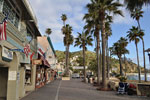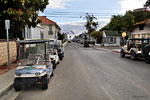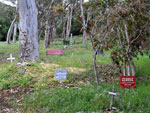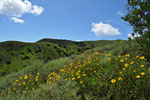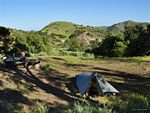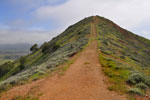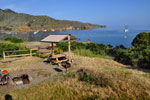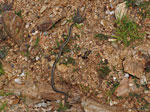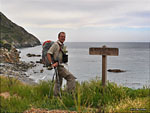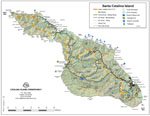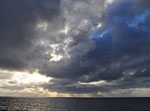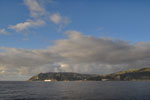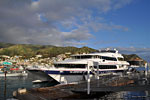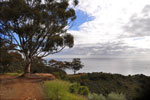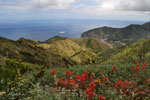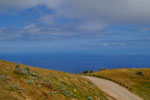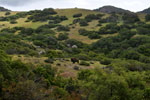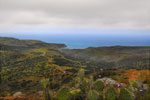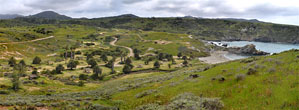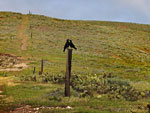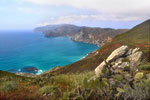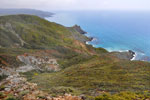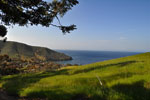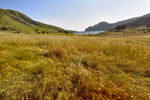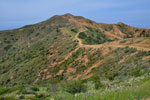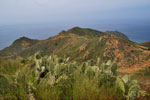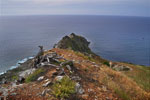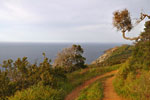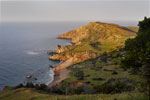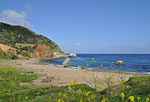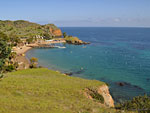 |
|
| Trans Catalina Trail, Santa Catalina Island, Los Angeles county, California 3 1/2 days, 52+ miles across the length of California's most beautiful island |
| Open for hikers in 2009, the newly finished Trans Catalina Trail (TCT) is poised to become one of the Southland's premiere multi-day hiking destinations. With it's route of challenging mountain ascents, wraparound ocean vistas, lakes and wetlands, palm groves and beaches and year-round accessibility, the TCT is a good workout and an enviable destination. Just 22 miles southwest of Los Angeles, Santa Catalina's proximity to a major metropolis belies the sense of remoteness and the welcome disconnect you feel on an island in the ocean. And the commute on the ferry is a novel beginning and end to your trip. Some detailed planning is required for this hike, as you need not only campground reservations for each night to get your hiking permit, but also ferry reservations to coincide with your hiking dates. Campgrounds fill up early in the year. Check my info section below for details. The trail designers have purposefully built the TCT to pass through all the island's various ecosystems - mountains, beaches, forests and wetlands - allowing hikers to experience all of Santa Catalina's natural charms. Much of the 37.2 mile TCT follows a network of existing dirt roads, but new trail construction in the central island and connector footpaths in the northwest bring the whole island together. The TCT opens up some sections of Santa Catalina that visitors have rarely if ever seen, including the lush central wetlands and rugged western sea cliffs that are only accessible on foot or horseback. The TCT criss-crosses Catalina Island from the southeast to the northwest end of the island, passing through the Little Harbor beach campground, Two Harbors village and terminating at remote Starlight Beach on the northeast coast near Land's End. There's no overnight camping at Starlight Beach, so you'll typically backtrack 5-6 miles to Parson's Landing for the night and the next day return the 8-9 miles to Two Harbors via the dirt West End Road for a total of approx. 52 miles that can be done easily in 3-4 days. I got off the trail near Mile 30 and took a different route to Lands End to climb Silver Peak and explore the northwest sea cliffs. The Silver Peak road has some very steep sections and adds a few more miles, but well worth the effort as the hike to Land' s End - one of the highlights of the journey - becomes a loop, eliminating the tedium of retracing the 5-6 miles at the end of the TCT as the builders envisioned. I'd highly recommend it. South to north across the island From the town of Avalon in the southeast corner of Santa Catalina, the Trans Catalina Trail climbs to the high ridges above the island's southern shores, offering a full panorama of the lower island, San Clemente island and the SoCal mainland. You can get on the TCT at the Hermit Gulch cutoff if you want to skip the first circuitous 6 miles. From the 360 degree view in the high hills above Avalon, you begin a slow descent to the rolling hills and wetlands of the interior. At remote Little Harbor, the path ascends to soaring heights above rugged western sea cliffs and then drops 1700 feet to Two Harbors, the low-lying isthmus that bisects Catalina Island. The northwestern section climbs high out of Two Harbors to the ridge line near Silver Peak, one of the island's highest, before dropping once again to Parson's Landing beach. The final 5 miles to the end at Starlight Beach will be an out and back trip as there is no overnight camping allowed beyond Parson's Landing. Back at Parson's Landing, you will typically return to Two Harbors via West End Road. Opening up the island For most visitors, Santa Catalina island is little more than the resort town of Avalon, or the tranquil beachside community of Two Harbors, as these are the only two developed areas. Daily ferries take visitors across the 22 miles of ocean from the ferry terminal in San Pedro to Avalon or Two Harbors in about an hour. There is a well-developed tourist industry here, a helpful Tourism Office and easy access to visitor information online. Less than 4000 people live on Santa Catalina island year round. You'll probably discover that island life is more relaxed and slower-paced and people are friendlier than you're used to on the mainland. Among other offerings, there is sport fishing and scuba diving, a glass bottom boat excursion, biking, swimming and tennis, a nightclub, shopping and dining. The island is home to large youth summer camps and has numerous facilities for boaters and yachtsmen. |
There are few cars and few paved roads on Santa Catalina. Golf carts are the transportation of choice for Avalon residents. Visitors can rent one. Most of the interior is undeveloped and wild, although dirt roads and utility lines mar much of the open spaces. In 2007, devastating wildfires burned miles of land in the mountains above Avalon, but re-growth has been rapid and there is little to show of it. The rugged mountain roads in the northwest are challenging and in spots, extremely dangerous for driving, but visitors can see much of this region in a rollicking Humvee four wheel drive tour out of Two Harbors. Until the TCT, there was no way to see virtually all of Santa Catalina on your own. History One of the coastal Channel Islands, Santa Catalina island was inhabited by the Tongva tribe as early as 7000 BC. They mined the soapstone for bowls and implements and traded it along the California coast. The TCT passes several spots where the ancients mined the stone near the airport. Not long after European discovers claimed the island for Spain and Portugal, disease and lack of fresh water lead to the demise of the native population. In the early years of the United States, the island came under the ownership of a string of wealthy entrepreneurs. The Santa Catalina Island Company was formed to develop the island as a resort. In 1919, William Wrigley Jr. - the chewing gum magnate who owned the Chicago Cubs - bought control of the SCIC and began financing the tourism industry in earnest with steamship ferries and building the Catalina Casino. With it's close proximity to Los Angeles and situated in the balmy southern California weather, the mountainous island was found to be the perfect movie set. For one film, bison (buffalo) were imported and before long, a large herd became established - a herd which still roams the island freely today, adding an interesting element of risk to your backcountry adventure. The Twenties and Thirties were a Golden Age as Santa Catalina gained a reputation as a playground for the rich and famous - attracting celebrities, musicians, politicians, authors, and all of the elite players from Hollywood. With the warm Southern California weather and azure blue waters, Avalon was perfectly situated as a retreat from the booming Los Angeles metropolis. Well-healed visitors came to dance to the top bands, to dine and see the shows. Wrigley's Chicago Cubs practiced here in the off-season. There was big game fishing, boating, gambling, sporting events, diving, swimming and spectator sports. Fortunes changed with the outbreak of war in the Forties when the military took over the island. Afterwards, cheap air transportation allowed those who could afford it easy access to more exotic destinations in Mexico, Hawaii or the Caribbean. Because of the threat of development, the Wrigley family established the Santa Catalina Island Conservancy (SCIC) in 1971 to preserve the island in its natural condition and promote responsible recreation. As owner of 88 percent of the island, the SCIC maintains control of almost all economic development and has led major efforts into restoring much of the island to it's natural condition. |
| I'd been jones-ing to hike this trail since I first heard of it opening Spring '09. I was pretty booked into the Sierra and couldn't get out here last year. The final campground on the trail, Parson's Landing, has only has 8 campsite's—all reservable—and they go early in the season. Camping beyond Parson's Landing isn't allowed. Without Parson's Landing to overnight, you'd want to hit the end-of-the-trail segment pretty quick as a Two Harbors to Starlight Beach and back trip, about 22-23 miles (not counting a trip to Land's End) and 2500-3000 feet of elevation gain/drop. I wanted to do the whole trail in an easy-paced hike and also visit "Land's End" - one of the out-stickin'est most points of SoCal. Land's End You get to the very western tip of Santa Catalina island by taking the left/NW fork at the Starlight Beach trail/road turnoff. It's about 2+ miles beyond the end of this split and most of it is a climbing scramble-thru-bramble after the road ends and not a maintained trail. There were no restrictions on visiting Land's End dictated other than disturb nothing and don't make them come out there and save you. I had to cancel reservations for a February trip due to rain. The ferry company requires 24 hours for a full refund, but I was told they sometimes make exceptions too. Spring is the perfect time to visit as Santa Catalina is covered in greenery and flowers galore. But seasonal weather is always a caution on an island in the ocean, even one in balmy southern California, and it's no fun to visit a beautiful spot like this when the skies are choked with clouds, visibility is limited and everything is wet and muddy. I checked the forecasts religiously for this trip, scheduled for a Tuesday through Friday to have as much solitude as possible and grab some nice shots, and lucked out with an accurately forecast clearing trend after several weeks of rain. My Osprey Exos 58 backpack with 3 days of food (4 lbs.) and gear (Tarptent, including a folding saw and 2.5 liters (4.9 lbs.) of water and electrolyte drink, my Nikon D5000 (2.5 lbs.) and my Garmin GPS added up 29.25 pounds I carried. Catalina Express doesn't allow flammables like camping gas on board but they don't ask and don't search your bags. Their list doesn't specifically mention denatured alcohol. You store your luggage on the lower deck with every one elses immediately after boarding but it's not completely off limits should you forget something. The ferry cost $81.50 roundtrip per person (April '10), 4 days parking was $48, 3 nights camping reservations $48, firewood + extra water 2 nights $24 (at Parson's Landing, extra water and firewood is included in the mandatory $24 reservation), for a total of $201 - not a low budget hike, but not over-the-top either. All in all, the timing was ideal - the trail and the campgrounds were empty, the weather was a breeze, with a few sun showers to brighten the plants, wash away the grit and add drama to the sky. The island showed off all it's charm. I was hoping for those giant puffy The Simpson's clouds after all the storming, but was satisfied with big sky clearing amidst the coastal front. So my planning paid off, my luck held out and I had the most enjoyable experience on this, my first visit to Catalina Island, that I could've hoped for. |
| Day 1: San Pedro to Avalon via ferry. TCT trailhead to Blackjack campground | |||
|
| Day 2: Blackjack campground to Two Harbors | |||||||||||||
|
|||||||||||||
|
Santa Catalina island is 22 miles southwest of Long Beach California in the Channel Islands in Los Angeles county. The 22 mile long island is situated in a NW to SE diagonal with the meridian grid. The city of Avalon and the unicorporated town of Two Harbors are the two population centers on this island. 88% of Catalina Island is owned by the Catalina Island Conservancy, a caretaking organization established by the Wrigley family, the island's long-term owners. |
The main point of disembarcation for regularly scheduled ferry service to Santa Catalina island is the Catalina Terminal below the Vincent Thomas bridge in San Pedro, serviced by Catalina Express or Catalina Cruises. Other ferry service is available from Dana Point or Long Beach Harbor. From I-405 in Long Beach, take I-110 S., exit Rt. 47 (Terminal Island/ Vincent Thomas Bridge) Do not go over bridge. Exit Harbor Blvd. At stoplight, bottom of ramp, go straight across Harbor Blvd. to Berth 95/Catalina Terminal. Parking - $12/day 310.547.4357 Take a ticket at entry, pay when you leave. Flammables and/or camping gas are not allowed on the ferry. You can buy it at Safeway in Avalon. San Pedro to Avalon or Two Harbors currently costs $81.50 per person roundtrip. Reservations are required. Most of the ferries service both Catalina towns before returning to San Pedro and your ticket is good for boarding or disembarking at either location. Phone numbers Catalina Express 800.622.2354 Conservancy House - 310.510.2595 / dial 108 Catalina Island Conservancy - 310.510.2595 Catalina Island Chamber of Commerce 310.510.1520 Camping 310.510.8368 Camping reservations: http://www.visitcatalinaisland.com |
More photos in the Trip Report top of page
TOP![]() Hikes Index
Hikes Index
Since 10.06
